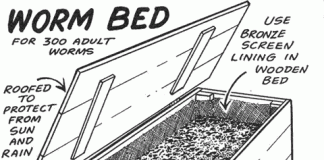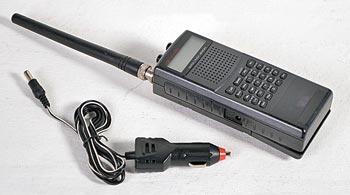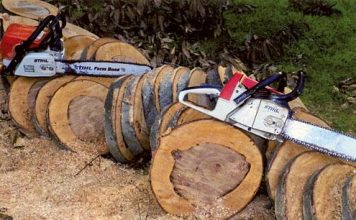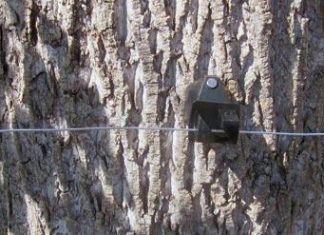 |
|
| Issue #69 • May/June, 2001 |
Baby Zane is probably the only newborn in Hollywood sleeping in a log crib made by his grandmother in Oregon, but it was inevitable.
|
He inherited a chainsaw-wielding grandma who builds log houses, and a horse-loving mom who dreams of a ranch someday. Their California apartment is decorated Western-style, right down to his diaper bag hanging on a saddlehorn, so the crib fits right in.
After hearing the exciting news from L.A. that a grandson was on the way, I was all a-twitter with ideas for homemade gifts, and turned to what I know best—logs.
I designed a crib that could be assembled and disassembled in minutes, so it could be moved into an upstairs apartment.
Then I ventured back into the forest with only a handsaw this time, but in the same old Ford pickup that has carried 800 logs for 3 houses (see BHM back issues #27, #32, #50).
If anyone out there wants to tackle this fun but time-consuming project, here’s how to do it with a small electric chainsaw, an orbital sander, and a ½-inch electric drill. (If you have a lathe and drill press, all the better.)
You can obtain a firewood or pole permit from the USFS or BLM. There are designated cutting areas and the fee is nominal.
My plan called for 4 posts, 8 rails, and 44 rungs. I gathered plenty of extra footage without cutting anything that was rooted in. The forest has downed-trees and fallen limbs everywhere. After a few minutes of tromping around you get an eagle-eye for spotting the perfect-sized logs.
List of raw materials:
- (4) 4″- 5″ diameter 4½ – footers (posts)
- (4) 3″- 3½” diameter 5 ½ – footers (side rails)
- (4) 3″- 3½” diameter 40 – inchers (end rails)
- (30) 1½” diameter 24 – inchers (side rungs)
- (14) 1½” diameter 30 – inchers (end rungs)
Carefully pick straight logs with very little taper (preferably Lodge-pole pine). Choose the longest logs and branches you can find and cut them to length later. You never know what’s under the bark until you peel it. When you’re back at home, you may find a knot or crack in just the wrong spot and you’ll have to move up or down with your measurements.
Build a rudimentary peeling stand out of 2 x 4’s with two braced “Xs” about 5 feet apart. The “Vs” will hold your logs and branches securely and allow turning them as you peel with a drawknife. (Drawknives are available at most hardware stores for about $35.)
Peel your stock, then sand the attractive knots, and smooth down anything rough.
Cut all posts and rails to length and lay them out on the floor, arranging them the way you’d like them to show in the finished crib. Number and mark them with masking tape. Each log will have its own character and you may have aesthetic preferences in pairing them up.
Do not precut your rungs to exact lengths yet. Cut them all 2 inches too long.
Now you’re going to make 8 giant rolling pins. Find the imaginary centerline of each rail by eyeballing it as best you can and draw a 2-inch circle on each end to mark the tenon size. Measure up 7¼ inches from each end and draw a circle around the log to mark tenon length.
Grab your chainsaw and lightly go back and forth along the length of the tenon, rat-a-tat-tat, moving the saw like a machine gun. As the chips fly, turn the log frequently until you shave it down to a 2-inch diameter cylinder the full length of the tenon.
Sand it smooth. Do this 16 times. You might want to practice on a scrap log first until you get the technique down.
You’re now ready to drill 16 holes in the 4 posts so you can plug the tenons in and erect the frame.
Use a 2-1/8-inch self-feed bit for fast boring and clean accurate holes. Measure up 14 inches and 38 inches respectively from the bottom of each post to mark your hole centers. Then turn the posts exactly 90° and measure up 10½ inches and 41½ inches to mark the second set of hole centers.
Secure the post any way you can (I clamped it in the peeling stand) and drill the holes.
Now for the moment of truth. Put the entire frame together to see how square it is. If your holes are a little “off,” you can make adjustments by shaving the tenons to fit. Use a plastic or white rubber mallet to “coax” it into submission.
When you get to this point, buy a standard crib mattress (52 inches x 27 inches) and make sure it fits into the rectangle you’ve created. If not, chisel and sand, chisel and sand. (Mattresses are about $40 – $80 at Sears and Wal-Mart.)
Next step is to determine the rung lengths. Take your 3-dimensional crib apart and lay the 4 separate sections down on the floor and square them up nicely (no parallelograms please.). Place your slightly overlength rungs 3¼ inches apart (on center) on top of the rails, to form a grid (see photo).
You’ll be gluing the rungs into holes drilled in the top and bottom rails, so run two horizontal strips of masking tape (exactly parallel to each other) at the depth you want the bottom of each row of holes and mark a line. If your log is tapered, holes will be deep on one end and shallow on the other. Still using the tape as your guide, mark the rungs at the length where they will bottom out in the holes, but not a micron longer. Too long won’t work but too short can be fixed with extra glue in the hole.
Now number the rungs in their correct order and lay them aside. Remove tape and turn the rail 90°, snap a chalkline for your row of holes and mark them 3¼ inches apart (on center). This measurement is critical because there is a safety law to protect babies. The actual space between rungs cannot exceed 23/8 inches.
Drill the holes to your depth-line with a 1¼-inch drill bit. Whittle or sand a “tenon” on both ends of all the rungs down to 1¼-inch diameter so they’ll plug into the holes. (A stationary table-top belt sander would come in handy here.)
With Elmer’s or Titebond, glue the rungs into the holes one row at a time (make gravity your friend when it comes to thin glue). When all the rungs are set and the glue is completely dry, put the crib together. Use a little “friendly persuasion” again with your mallet, and make sure all members fit tightly together, and are plumb, level, and square.
It’s now time to drill a peg hole down through the top of each tenon. Place a short dowel on the tenon, where you want the hole, vertically as close to the post as you can get, and draw around it with a pencil. To insure the pegs will pull the frame together when they’re “drifted” in, you may need to chisel away grooves in the posts above where the pegs enter, so you can slide them into the holes. Gnarly logs always require custom fitting. Drill the holes with a long 5/8-inch drill bit.
Make 16 pegs 6 inches long out of 5/8-inch dowels. Whittle or sand each one to a slight taper and then drive ’em home. This is the fun part.
Finish the crib with a non-toxic water-based polyurethane stain and you’re ready to “hang” the spring to receive the mattress. You can buy a standard-sized flat crib spring at almost any used baby-clothing store, or Goodwill or Salvation Army, for $5 – $10. Plywood is also an option. Put hooks or brackets at two separate levels so you can adjust the mattress height as the baby grows. I set my hooks at 17 inches and 25 inches (up from bottom of posts). Install the spring and mattress.
You’re finished. Make the bed with a mattress pad, a new sheet, a padded crib liner, and a soft homemade quilt and it’s ready for baby—maybe even generations of babies.
(Editor’s note: You can commission Dorothy to handcraft a log crib for your baby, if you like the style, but not the work involved. For details, write to her at 2909 Dead Indian Memorial Road, Ashland, Oregon 97520.)
Learn more about Dorothy and/or contact her at her website www.dorothyainsworth.com


























Way to go, hon. Your family must’ve been thrilled at the time (Zane would be 20 yrs old now)!